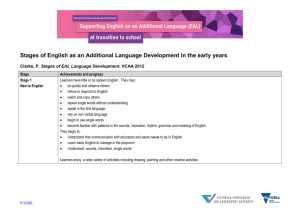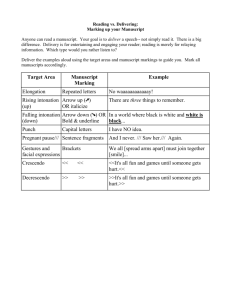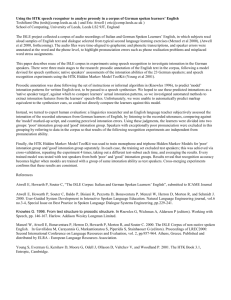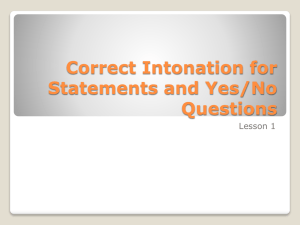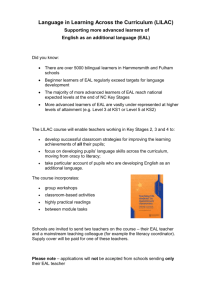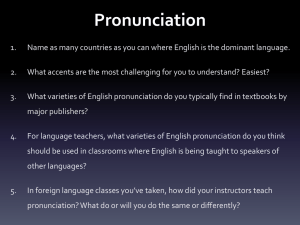Comparison of stages of EAL learning * the preschool child and the
advertisement
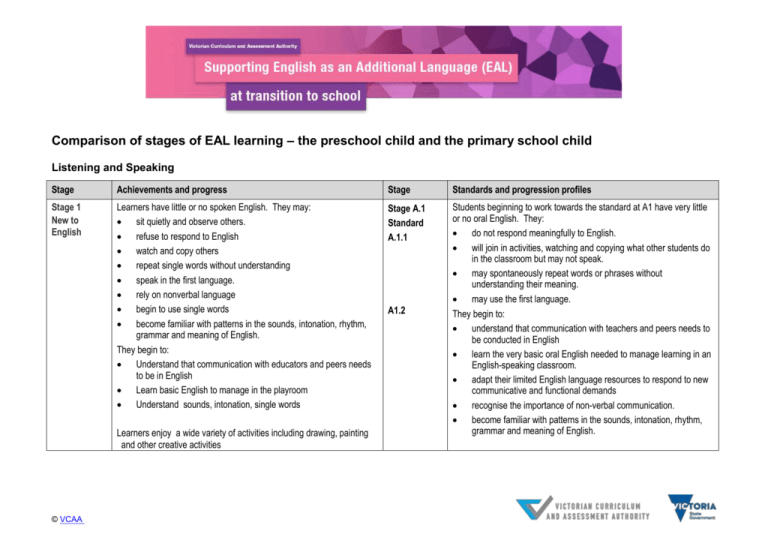
Comparison of stages of EAL learning – the preschool child and the primary school child Listening and Speaking Stage Achievements and progress Stage Standards and progression profiles Stage 1 New to English Learners have little or no spoken English. They may: sit quietly and observe others. refuse to respond to English watch and copy others repeat single words without understanding speak in the first language. rely on nonverbal language begin to use single words become familiar with patterns in the sounds, intonation, rhythm, grammar and meaning of English. They begin to: Understand that communication with educators and peers needs to be in English Learn basic English to manage in the playroom Understand sounds, intonation, single words Stage A.1 Standard A.1.1 Students beginning to work towards the standard at A1 have very little or no oral English. They: do not respond meaningfully to English. will join in activities, watching and copying what other students do in the classroom but may not speak. may spontaneously repeat words or phrases without understanding their meaning. may use the first language. They begin to: understand that communication with teachers and peers needs to be conducted in English learn the very basic oral English needed to manage learning in an English-speaking classroom. adapt their limited English language resources to respond to new communicative and functional demands recognise the importance of non-verbal communication. become familiar with patterns in the sounds, intonation, rhythm, grammar and meaning of English. Learners enjoy a wide variety of activities including drawing, painting and other creative activities © VCAA A1.2 Comparison of stages of EAL learning – the preschool child and the primary school child Stage Achievements and progress Stage 2 Becoming familiar with English Learners begin to show confidence in speaking in English. They: start to understand some English that is spoken greet the educators and other children begin to name single objects and actions follow simple directions. communicate in single words join in singing, action songs with repetition repeat words of others They point to and name objects in books They follow simple directions They communicate in basic English, predominantly single words including in routine and familiar situations Stage At Stage A1, students communicate in basic English in routine, familiar, social and classroom situations. They: follow and give simple instructions, exchange basic personal information and negotiate well-known, predictable activities and contexts. begin to modify their responses and manner of interaction to match the responses of others, and to the context. use simple learned formulas and patterns, and create original utterances by substituting words. Learners are now growing familiar with playroom speech. They: start to use single words to convey meaning. use frequently heard phrases in a formulaic way. use some basic communication and learning strategies to participate in and sustain interaction understand more than they are able to say. gain confidence from hearing familiar and repetitive language and they enjoy looking at books and listening to stories. © VCAA Standards and progression profiles Page 2 Their utterances are characterised by a short ‘telegraphic’ structure, simple subject/verb/object construction and overgeneralisation of rules. They: use some basic communication and learning strategies to participate in and sustain interaction in English. recognise that intonation carries meaning, and they listen for key words and for repetition of words and phrases. use comprehensible pronunciation, stress and intonation. use classroom resources such as pictures to help them communicate. Comparison of stages of EAL learning – the preschool child and the primary school child Stage Achievements and progress Stage Standards and progression profiles Stage 3 Becoming confident as a speaker of English Children show greater understanding of English in a variety of contexts and show increasing fluency in spoken English. They: use basic oral English to manage learning and undertake some learning through English. are willing to initiate as well as respond are familiar with patterns in the sounds, intonation, rhythm, grammar and meaning use both single words and formulaic language to convey meaning take part in everyday activities and routines relying heavily on a supportive teacher or peer. demonstrate greater flexibility with spoken English. combine single words into short sentences. use comprehensible pronunciation, stress and intonation. Children fluent in their first language will show understanding of two languages and can switch from the first language to English with different speakers. A2.1 Beginning Students beginning to work towards the standard at A2 communicate effectively in English, using simple sentences and learned formulae. They: take part in everyday activities and routines, relying heavily on a supportive teacher or peer. can use some appropriate terms when requested, relying on nonverbals to indicate level of politeness in other pragmatic events. use comprehensible pronunciation, stress and intonation. can join in well-rehearsed and well-known songs, by following peers and/or teacher. © VCAA Page 3 Comparison of stages of EAL learning – the preschool child and the primary school child Stage Achievements and progress Stage Learners depend less on formulaic or rehearsed language and show Stage A2 Stage 4 the beginnings of the use of grammatically correct sentences. They: Demonstrated A2.2 can distinguish between ‘he’ and ‘she’, and begin to use the competency definite or indefinite article correctly. as a speaker of English are more interested in communicating meaning rather than correctness. are beginning to take part in discussions between educators and other children. initiate and respond in conversation. are now able to communicate in a range of different learning A2.3 situations. can express ideas and take part in discussions with adults and their peers. identify key points of information in discussions about familiar topics, and in new topics when supported by visual material, appropriate pace of delivery, and discussion which links their prior knowledge to the new context. follow a short sequence of instructions. demonstrate competence in using English with a range of speakers. Greater confidence in speaking English enables them to take an active part in extended conversation. Conversations are now jointly constructed and learners can engage in cognitively challenging tasks. Clarke, P. Stages of EAL Language Development. VCAA 2012 The EAL Learning Continuum P10. DEECD. 2013 © VCAA Page 4 Standards and progression profiles Students progressing towards the standard at A2 can participate in routine exchanges like greetings and simple classroom routines without great difficulty. Discussions between teacher and learners at native speaker speed are still too difficult for them to participate in. They: are able to generate their own language beyond formulae and two word utterances. use approximations of structures as they test hypotheses At Stage A2, students communicate in an expanding range of predictable social and learning situations. They: express ideas and identify key points of information in classroom discussions about familiar topics, and in new topics when they are well supported by visual material, appropriate pace of delivery, and discussion which links their prior knowledge to the new context. follow a short sequence of instructions related to classroom procedures and learning activities. negotiate familiar social and learning situations, using English appropriate to the situation. adjust their speech choices in response to audience and topic. combine known conversational formulas and vocabulary, including features of texts read in class, and apply some grammatical rules to make original utterances, of varying grammatical accuracy. sustain communication by negotiating turn-taking, and by using strategies such as asking a speaker to repeat or to speak slowly, or asking what a word means.
